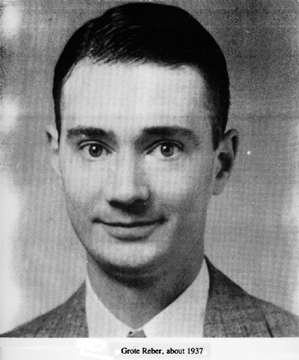
To Open The Sky


Grote Reber (1911-2002)
Unsung Pioneer of Radio Astronomy
"There were," Grote Reber decided in the 1930s, "no more worlds to conquer" in radio communication. Reber was a radio engineer in Wheaton, Illinois, and an avid "ham" — an amateur radio operator. As a ham, he communicated with other amateurs all over the world, winning awards for the numbers of DX (distant) contacts he amassed.1
But sometime during that decade, he learned of Karl Jansky's 1932 discovery of natural radio emissions from space. For Grote Reber, it represented a whole new kingdom of possibilities. You could say the sky had opened up for him.
The first challenge the young engineer faced was how to detect and measure the newly found natural emissions. He analyzed the problem as an engineer would, concluding that the first thing he needed was a parabolic ("dish") antenna. But such antennas were nearly unheard of in 1937 at any size, let alone the 31.4-foot dish his calculations told him he needed in order to get useful signal strengths. So he bought himself some metal and built one himself, installing it in his back yard. He later recalled that the strange contraption made him the talk of the neighborhood. His house was a minor tourist attraction for some time thereafter.
Reber's next challenge was the receiver. He met it by designing and building his own, thereby advancing the state of the electronics art. He wanted to observe at a 10-cm2 wavelength; this meant electronics that worked at 3,000 MHz. Recall that this was before World War 2, when vacuum tubes were still fairly new and 30 MHz was the upper limit for commercial radio gear. Indeed, only 25 years had passed since the US government had relegated all frequencies above 1.5 MHz (200 meters) to amateurs because those frequencies were thought to be useless. Success at designing, building and operating a receiver for frequencies 2,000 times higher would be an immense achievement in itself, even today.
The system he constructed first detected Jansky radiation in 1939. Two years later, Reber produced the first radio map of the sky. He kept up his observations for several more years at Wheaton, later moving to Tasmania where he did radio astronomy work until at least January 2002, eleven months before he died on 20 December 2002, just two days shy of his 91st birthday.
Though he was not a professional scientist, Reber's research papers were published in journals such as Nature, The Astrophysical Journal, Proceedings of the Institute of Radio Engineers, and the Journal of Geophysical Research.
The honors and awards he received are also those that normally go to scientists professionally trained in astronomy. These honors include the Henry Norris Russell Lectureship of the American Astronomical Society, the Astronomy Society of the Pacific's Bruce Medal (1962), The National Radio Astronomy Observatory's Jansky Lectureship (1975) and the 1983 Jackson-Gwilt Medal from Britain's Royal Astronomical Society.
Sources for further information
- Grote Reber and his Radio Telescope (NRAO)
- Publications by Grote Reber (NRAO)
- Archive of Grote Reber's papers (NRAO)
- Early Radio Astronomy: The Ham Radio Connection (NRAO)
- Grote Reber, ex-W9GFZ (by Dave Finley N1IRZ, SETI League)
- Grote Reber: Radio Engineer and Physicist
-
"Endless, Boundless, Stable Universe" — a paper by Grote Reber
Links updated 26 Apr 2009.

